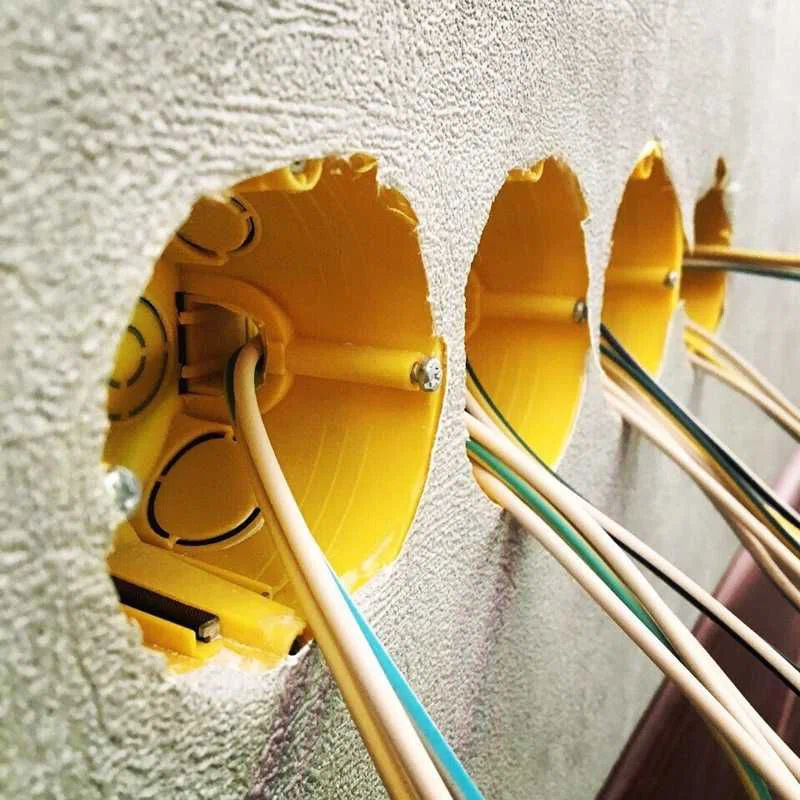
Professional Socket Installation: Steps, Tools, and Cost
Learn how to install a wall socket in your apartment yourself. Step by step, we will consider the choice of a socket, drilling a niche and properly mounting it. If you find it difficult, contact the master. Pricing for installation of wall sockets varies depending on the material of the wall. Find a reliable specialist and ensure the reliability and safety of your electrical wiring.
Content
- Step No. 1: Preparing the tools
- Step #2. Drilling the recess for the socket outlet
- Step #3. Fitting the socket outlet
- What is the cost of a craftsman's service to install a socket outlet
- Frequently Asked Questions
- What tools will I need to install a sub socket?
- Do I need to turn off the electricity before installing the socket outlet?
- How do I connect the wires to the new sub socket?
- Is it possible to install the socket outlet yourself or is it better to contact a specialist?
- How do I test the socket outlet after installation?
When starting to install a socket, it is necessary to first install a sub-socket, which is a special niche with a seat inside. This element not only provides protection against electric shock and fire, but also reliably fixes the device itself. Let's talk about the correct way to independently install a sub socket in the apartment and the approximate cost of this service when contacting a specialist.
Step No. 1: Preparing the tools
Before you start installing sub sockets, you need to carefully prepare all the necessary tools. Your arsenal should include a punch, construction level, wire detector, tape measure, pencil and knife. However, it is recommended that you pay attention to a few important details to ensure efficient and accurate installation.
First, the choice of sub sockets depends on the type of wall in which it is planned to install them. If it is a concrete wall, a brick wall or a wall made of gas blocks, then regular sockets will be an appropriate choice. However, if your wall is hollow, such as chipboard or plywood, you should look for sockets with special clamping feet to ensure a more secure attachment.
Second, properly measuring and marking the location of the sockets are important steps before installation. Use a construction level and tape measure to accurately locate the sockets on the wall. Using a pencil, make marks on the wall according to your measurements. This will help you install the sockets accurately and evenly.
Thirdly, before you start drilling holes in the wall, it is recommended that you use a wiring detector. This device will help you detect electrical wires or other hidden objects that may be behind the wall. This way, you will avoid damaging the wiring and ensure safety during the installation of the sub sockets.
Finally, be careful to choose the right tool for drilling holes in the wall. A hammer drill with the appropriate drill bits for the selected wall material will ensure more efficient and accurate drilling. Don't forget to use a knife to remove possible material residue and make the holes look neater.
Preparing the tools before installing the sockets is an important step that affects the final result of the work. Give enough time and attention to this phase of the process to ensure the reliability and aesthetic appeal of the installed sockets. Remember that proper preparation of tools is the key to successful completion of the task.
Step #2. Drilling the recess for the socket outlet
When starting the process of drilling out the recess for the socket outlet, it is necessary to follow certain technical measures and sequence of actions in order to obtain a quality result. It is important to remember that safety should always come first when working with electrical wiring.
Before you start drilling the niche, make sure that you have chosen the right nozzle for the perforator. In order to drill through hard materials such as concrete or brick without problems, it is recommended to use a diamond-coated bit or diamond inserts with a larger diameter than the socket itself.
Move the drill to the previously selected marking point and aim the drill bit at the center. Start the drill and begin to go deeper into the wall with gradual application of pressure. Watch the drilling process to maintain a steady and straight path.
Gradually advance until the drill bit is completely immersed in the wall material. The resulting niche should have a round shape and be large enough to accommodate the socket outlet.
In addition to the niche, it is necessary to drill a groove for the future cable. Use a bolgar to create a longitudinal groove that will serve for laying the electrical cable from the nearest outlet or distribution board. When drilling the grommet, remember to maintain a certain distance between the cable and the outlet to prevent possible crossings and conflicts of existing wiring.
It is important to note that drilling out a recess and creating a grommet are demanding tasks that require some experience and knowledge of electrical wiring. If you do not have sufficient training or experience, it is recommended that you contact a qualified professional to avoid potential problems and ensure the safety of the work.
It is interesting to note that modern technologies and tools allow you to greatly facilitate the process of drilling out a niche for a sub socket. For example, some drills are equipped with a dust extraction function, which significantly reduces the amount of dust generated during work. This makes it easier to maintain cleanliness and provides a more comfortable environment for work.
There are also special crown attachments equipped with built-in cooling systems that prevent the tool from overheating during the drilling process. This increases the efficiency of work and extends the life of the nozzle.
Depending on the wall material and working conditions, additional tools and accessories may be required. For example, drilling recesses in reinforced concrete walls may require the use of impact drills or special hydraulic hammers.
Step #3. Fitting the socket outlet
There are several important steps to successfully installing a socket outlet. Take the socket and assess its dimensions, making sure it fits perfectly into the chosen niche. If necessary, use a knife or other tool to carefully adjust the dimensions of the socket.
Moving on to removing the plugs with a knife, pay attention to their location and quantity. Lack of pre-planning can lead to undesirable consequences. When removing plugs, follow the manufacturer's instructions and use caution to avoid damaging walls and wiring.
The next step is to run the cable through one of the holes. It is important to choose the correct hole to connect the cable to the outlet itself. Make sure that the cable is not subjected to excessive tension or kinking to ensure a safe and secure connection.
As you begin to install the sub socket itself, consider several factors. First, the distance between the hole and the casing should be sealed with a mortar such as putty or gypsum. This will ensure a strong fixing and prevent possible seepage and dust penetration. It is recommended to use quality materials and follow the instructions to achieve the best results.
Secondly, pay attention to the accuracy of the alignment of the sub socket in the niche. Use a level to make sure it is horizontally and vertically aligned. Improper alignment can affect the aesthetics of the installation and make subsequent stages of the job more difficult.
When the sub socket is installed and secured, test its functionality by connecting the cable to the outlet. Make sure that the electrical connections are secure and there are no signs of malfunction. If you find any problems, it is advisable to contact a professional to avoid possible risks and damage.
Do not forget about safety during the installation of the socket outlet. Make sure that the electricity is turned off and use the appropriate tools and protective equipment before starting work. If you are not sure of your skills or experience, it is better to contact professionals to guarantee a quality and safe result.
What is the cost of a craftsman's service to install a socket outlet
Installing sockets is an important task that requires professional skills. If you have never done electrical work before and the installation instructions seem complicated to you, it is recommended to contact an experienced craftsman. A qualified specialist will easily handle the process, ensuring the reliability and safety of the installation.
When carrying out a sub socket installation, it is important to consider several factors, including the material of the wall and the required skills for the job. Different types of walls may require different approaches, which affects the cost of the handyman's service. Let's take a look at some of the specifics and rates associated with sub socket installation.
Aerated concrete and concrete wall are considered more difficult to work on because of their features. When installing sub sockets in such walls, the master needs to use specialized tools and techniques. As a result, the price of installation in aerated concrete and concrete wall can be higher compared to other materials. The cost of such work usually ranges from 16 to 22 Georgian lari per piece.
However, if you have a brick wall, the cost of installing a sub socket may be more affordable. A craftsman will be able to create a hole for the socket at a more attractive price. Usually, the price of installation in a brick wall is at the level of one and a half times lower compared to aerated concrete or concrete.
Another common material for installing sub sockets is drywall. Installing sockets in drywall is a simpler and more economical procedure. The rates for such work usually range from GEL 8 to GEL 16 per job. This can be a good option for those who want to save money without compromising on quality.
In addition, when you contact a sub socket fitter, you can additionally order the socket itself. This will save you time and make sure that the installation is done according to your requirements and preferences. The craftsman will help you choose the right outlet and install it correctly, ensuring reliability and safety.
As you can see from the above examples, the cost of the master's service for installing a sub socket depends on several factors, such as the type of wall and the complexity of the work. When choosing a master, it is recommended to take into account his experience and reputation to be sure of the quality of services provided. Remember that a reliable craftsman will do everything possible to ensure that the installation of sub sockets went smoothly and safely, providing you with comfort and convenience in the use of electrical devices.
Frequently Asked Questions
What tools will I need to install the socket outlet?
You will need a screwdriver, pliers, insulation tape and the socket itself.
Do I need to turn off the electricity before installing the socket?
Yes, you must turn off the electricity through a circuit breaker before installing the socket outlet.
How do I connect the wires to the new receptacle?
The correct connection of the wires to the new socket outlet should be done in accordance with the color coding of the wires.
Is it possible to install the socket outlet yourself or is it better to contact a specialist?
If you have sufficient skills and knowledge, you can install the socket outlet yourself. However, if you are uncomfortable or unsure of your abilities, it is better to contact an electrician.
How do I test the socket outlet after installation?
Turn on the electricity and check that the socket is working properly. Plug in the device and check that it is receiving power.







23 comments
Log in to leave a comment